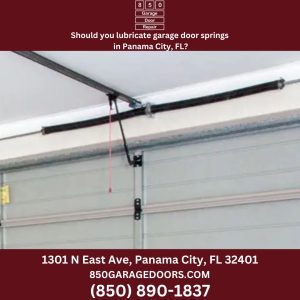
Why Garage Door Spring Maintenance Matters
The Role of Springs in Garage Door Operation
Springs act like the counterbalance that makes a heavy door feel light. When you open or close the door, the springs store and release energy so the opener and the lifting cables do not work alone. Torsion springs sit above the door and twist to build force. Extension springs usually mount along the tracks and stretch to carry load. In both designs, friction and corrosion are the enemies of smooth movement. A small amount of the right lubricant reduces metal to metal contact, controls squeaks, and helps the coils move freely.
What Happens When Springs Wear Out
With time, springs lose tension and the metal can fatigue. You may notice the door slamming shut, drifting open, or sitting uneven on the floor. The opener can start to strain, which shows up as slower movement, grinding sounds, or a burning smell. In the worst cases, a worn spring will break, which can damage nearby parts and put people at risk. Routine lubrication does not fix a fatigued spring, yet it limits friction that speeds up wear. Think of it like putting sunscreen on your skin during a day on Panama City Beach. The sun will still rise tomorrow, but you have given yourself protection against the most direct harm.
Risks of Ignoring Maintenance
Ignoring spring care can lead to noisy operation, rust buildup, and premature failure. In a coastal area, a door that runs dry can develop a red brown film on the coils faster than you expect. That surface corrosion increases friction and leads to pitting, which weakens the metal. Once pitting begins, every open and close cycles the stress through a less uniform surface. The door may work today, but the safety margin gets thinner.
Should You Lubricate Garage Door Springs
Benefits of Regular Lubrication
Reducing Friction and Noise
Lubricant forms a thin film that separates the rubbing surfaces as the coils move. This reduces scraping sounds and vibration. If your door squeals during the first cool morning of a sea breeze, a careful application often brings back quiet function.
Extending the Lifespan of Springs
Lower friction means lower heat and less metal wear. By limiting direct contact, you slow the microscopic nicks and scratches that develop into cracks. In the same way that regular oil changes protect an engine, periodic spring lubrication supports steady performance over many cycles.
Improving Overall Door Performance
A lubricated spring helps the opener work within its design load. You will often notice cleaner starts and stops, fewer hesitations in mid travel, and less bounce when the door reaches the floor. Cables and pulleys also see less shock, which can reduce small alignment problems that creep in over time.
Risks of Over Lubricating or Using the Wrong Product
Too much lubricant attracts dust and sand that ride in on coastal winds. This can lead to a sticky paste on coils and tracks that actually increases drag. Using a thin penetrating cleaner instead of a real lubricant can also strip away protective oils and leave metal bare. The goal is a light, targeted coat only on the right parts.
Choosing the Right Lubricant for Panama City Conditions
Why Florida Humidity and Salt Air Matter
Moist air accelerates surface oxidation on steel. Salt crystals in the air act like tiny sponges that hold moisture against the metal. Together, they work like a slow moving corrosive film. A quality garage door lubricant with moisture resistance and rust inhibitors gives your springs a better chance to stay clean and smooth between service visits.
Recommended Lubricants for Garage Door Springs
Use a silicone based or lithium based spray that is marketed for garage door hardware. These products cling to metal, resist wash off, and are light enough not to gum up. A light household oil can help in a pinch, but a purpose made spray usually delivers the right balance of protection and cleanliness. Always read the label and choose a product that mentions corrosion protection and temperature stability.
What to Avoid WD 40 and Other Mistakes
WD 40 is a helpful cleaner and water displacer, yet it is not a long term lubricant for springs. It can flush away grime at first, then evaporate and leave the metal without a protective film. Grease is another common misstep. Thick grease traps grit and becomes abrasive in a sandy environment. Also avoid spraying the entire assembly without control. Tracks, rollers with bearings, and hinges each have their own care needs. Focus on the spring coils and the center bearing if accessible, and do not soak the parts.
| Condition | Suggested Action |
|---|---|
| Light squeak at start or stop | Apply a light coat of silicone or lithium spray to coils |
| Visible surface rust on coils | Wipe gently to remove loose residue then lubricate |
| Door jerks or hesitates mid travel | Lubricate springs and test balance then observe |
| Heavy grinding noise | Stop use and schedule a professional inspection |
| Uneven closing or door drifts open | Call a technician for tension check and possible repair |
How to Lubricate Garage Door Springs Safely
Tools and Safety Gear You Will Need
- Protective glasses to shield from mist or debris
- Work gloves for grip and to keep lubricant off your skin
- Garage door lubricant in silicone or lithium spray form
- Clean rags for light wipe down and overspray control
- A sturdy step stool if you need a small height boost
Step by Step Lubrication Process
Preparing the Garage Door
Close the door fully. Unplug the opener to prevent an accidental start. If your system has a manual release cord, pull it so you can move the door by hand. This makes it easier to feel improvements and keeps the opener from masking a problem.
Applying Lubricant to the Springs
Stand to the side, not directly under the spring. Hold a rag behind the coils to catch mist. Apply a light, even coat across the visible coils. Rotate the tube on the nozzle for control and aim for a thin film rather than a wet drip. One quick pass is usually enough for each spring.
Testing the Door After Lubrication
Lift the door by hand to about waist height and release. A balanced door should stay in place or move very slowly. Listen for changes in sound. If the motion is smoother and the squeak is gone, you have likely applied enough. Reconnect the opener and run one complete cycle while you stand clear of the path.
Safety Precautions to Keep in Mind
- Never remove spring hardware without training because springs are under tension
- Keep spray away from the belt or chain and from the opener housing
- Do not soak tracks because rollers need to grip the track surface
- Avoid ladders on uneven floors to prevent falls during the task
- Stop if you see frayed cables, cracked coils, or bent brackets and call a professional
When Lubrication Is Not Enough
Signs Your Springs Need Professional Attention
Look for gaps in the coils, deep rust pits, or a spring that looks stretched out at rest. Watch for repeated slamming shut, a door that feels heavy, or an opener that strains or reverses for no clear reason. These are warning signs that go beyond simple lubrication.
When to Repair vs Replace Springs
Surface rust and minor squeaks often respond to cleaning and lubrication. A spring that has reached its cycle life or has visible cracks needs replacement. In many cases, it makes sense to replace springs in pairs so both sides carry equal load. The decision is about safety and reliability rather than delay and patching.
Why DIY Spring Replacement Is Dangerous
Springs store significant energy to lift a heavy door. Incorrect tools or procedures can lead to sudden release of force and serious injury. A trained technician brings the right bars, fixtures, and know how to adjust torque and set the system to the correct balance. Homeowners can safely handle light cleaning and lubrication, yet spring replacement calls for professional service.
Professional Garage Door Service in Panama City, FL
Benefits of Hiring a Local Expert
A local professional understands the mix of humidity, salt air, and seasonal storms that influence garage hardware near the Gulf. That experience guides product choice, adjustment strategy, and service intervals. It also helps with spotting related issues like corroded fasteners or swelling wood trim that can pinch tracks.
Regular Maintenance Plans for Long Term Savings
Consistent inspections and tune ups reduce surprise outages and protect the opener and rollers from strain. A typical plan includes spring lubrication, balance testing, cable and pulley checks, and fastener tightening. In a coastal area, these small steps prevent gradual corrosion from becoming a large repair.
How Often Should Springs Be Inspected in Florida
At minimum, inspect springs visually every three months and lubricate them two or three times per year. If your door sees heavy daily use, add one more light application during peak humidity. After a tropical storm or a long spell of salt laden breeze, a quick check for rust film is smart.
Conclusion
Lubricating garage door springs in Panama City is a smart habit that supports quiet movement, protects against corrosion, and helps the entire system last longer. The answer to the original question is yes, with the right product and careful technique. Keep the application light, avoid products that are cleaners rather than true lubricants, and know when to call a professional if you see warning signs. For homeowners who want dependable service and guidance tailored to the coastal climate, the team at 850 Garage Doors is a trusted resource. If you have concerns about noise, rust, or balance, reach out to the experts at 850 Garage Doors or explore more information on their website for help that keeps your door safe and reliable year round.


